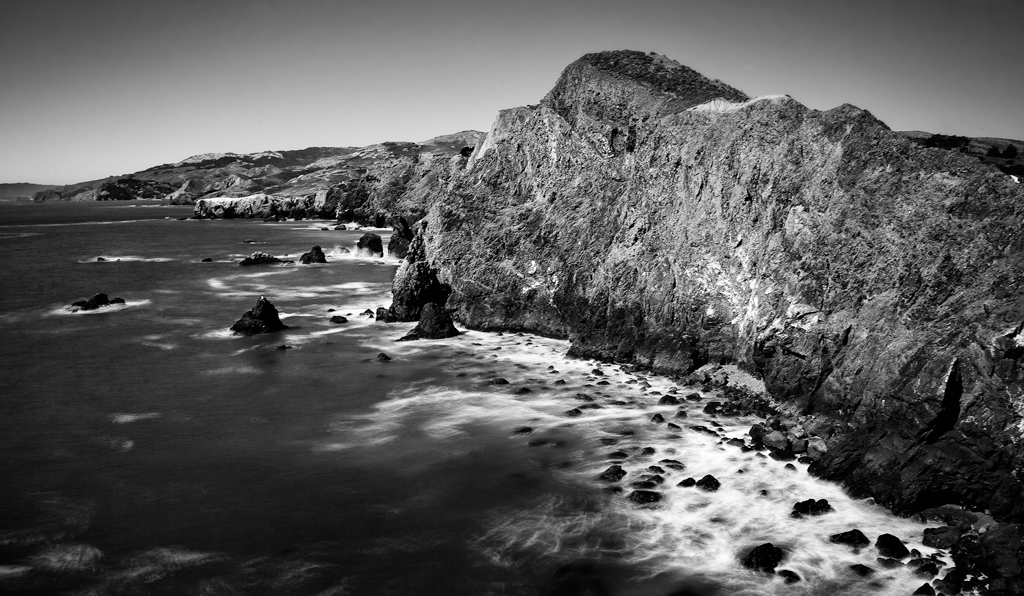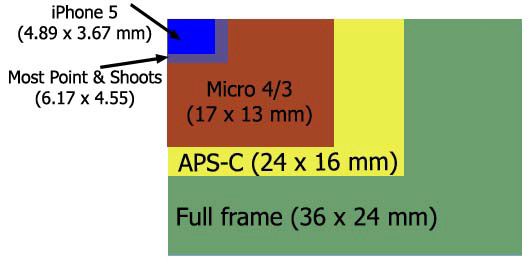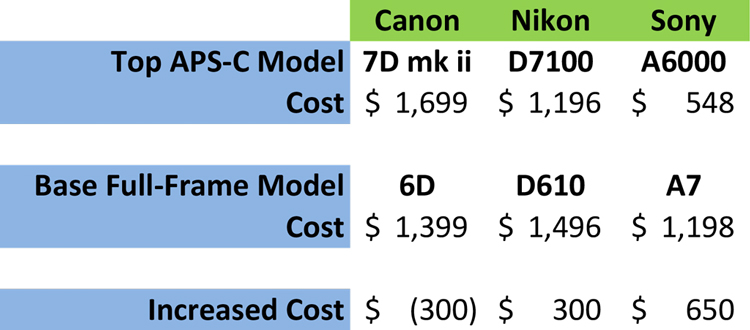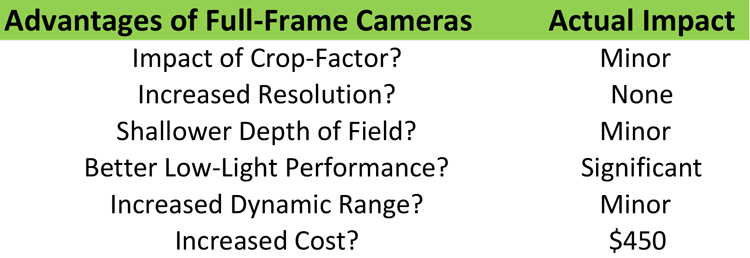
Back in the days of film cameras, 35 mm film was pretty well ubiquitous. We all used it. It was called 35 mm film because each strip took exposures that were 35 mm wide. It was actually considered small film in its time, and most professional photographers used larger format film. When digital came along, however, the sensors of the cameras were much smaller than 35 mm film. Here is a chart showing the different sized sensors available on digital cameras:

For several years, APS-C sensors were the state of the art for high-quality digital photography. They are still used widely. Camera manufacturers did make digital sensors that were the same size as 35 mm film, which were called “full-frame” because they were the full size of the 35 mm film, but they were far too expensive for the average photographer.
The Full-Frame Advantage
The larger sensor size has always had advantages for photographers. An obvious effect is that smaller sensors result in what is called a crop-factor, since less of the image coming from the lens will fit on the smaller sensor. This effect is a detriment to wide-angle photos. In addition, the larger sensors are also obviously capable of holding more megapixels. Besides these obvious examples, there are other effects, such as:
- Better low-light performance stemming from the use of larger megapixels on the full-frame cameras;
- Larger dynamic range, largely for the same reason; and
- Ability to achieve shallower depths of field.
Starting with Canon’s 5D line, the price of full-frame cameras began to come down significantly. Now, while full-frame DSLRs can still be quite expensive, you can buy full-frame DSLRs for as cheap as $1,399. But they are still more expensive than cameras with smaller sensors.
While full-frame cameras have come down in price, there have been other developments that make the jump to full-frame unnecessary. Camera manufacturers have made huge strides in image quality for cameras with smaller sensors. Many photographers swear by cameras with sensors that are even smaller than APS-C (such as the Micro 4/3 size sensor).
So the question arises: is full-frame worth the extra cost? Let’s take a look at the state of the advantages, and the amount of the extra cost.
Advantage No. 1: No Crop Factor
Because an APS-C sensor is smaller than a full-frame sensor, only a portion of the image from the lens will show up on the sensor. In other words, if you take a lens that is designed to reflect light onto a full-frame sensor, and then you put that lens on a camera with a smaller sensor (like an APS-C) essentially light will spill over the edges of the sensor. This results in apparent magnification of the image that we call “crop factor.” The difference between APS-C and full-frame is about 40%.
Here’s how it works in practice: when you shoot with a 24 mm lens on a full-frame camera, it acts like a 24 mm lens, but when you put that same lens on an APS-C camera, it acts like a 34 mm lens (40% crop factor). This is a problem when you want to shoot wide-angle.
Camera manufacturers have largely solved this issue. They now make lenses specially designed for APS-C cameras that are super-wide angle. In fact, they are now making lenses that are as wide as 10mm. Accordingly, the problem of crop-factor is not really much of an issue. Because the lenses for full-frame cameras tend to be slightly higher quality, I will still chalk this up to a minor advtange of full-frame cameras. But it is slight.
Crop Factor Result: Minor Advantage for Full-Frame
Advantage No. 2: Higher Resolution
As mentioned above, a larger sensor ought to yield higher resolution. The larger sensor provides more room on which to fit more megapixels. But a quick look at a chart comparing the megapixels of APS-C and full-frame cameras shows that really isn’t so:
Many of the APS-C cameras contain 24 megapixels, which is about average for the full-frame cameras.
Are there full-frame cameras with higher resolutions? Yes. The Nikon D810 and Sony A7R stand out in this department with 36 megapixels. But there are plenty of full-frame cameras with no more megapixels than APS-C. In fact, there are some full-frame cameras with less megapixels than the APS-C models. If I included the professional-grade models of Canon and Nikon in this chart, they too would have less than 24 megapixels, which is standard in APS-C cameras. As a result, I would not consider resolution an advantage of a full-frame sensor.
Result for Resolution: No Advantage for Full-Frame
Advantage No. 3: Shallow Depth of Field
It is a truism that larger sensors allow you to capture shallower depths of field in your pictures. This is true and always has been. There is no way to get around it.
The difference is not that great though. Further, in the context of outdoor photography an extremely shallow depth of field is not often something you are seeking. Typically you will want a wide depth of field.
This is an advantage of full frame cameras, but again, it is relatively slight.
Result: Minor Advantage for Full-Frame
Advantage No. 4: Low-Light Performance
In a prior article, I reported on test results comparing the low-light performance of full-frame and APS-C cameras. The results of that testing are in this chart:
The cameras with full-frame sensors had significantly better low light performance than those with APS-C sensors. The tests show that full-frame sensors were able to capture quality images with over a full-stop less light than APS-C cameras. For more information on this testing, see this article. In any case, there is no denying that better low-light performance is a significant advantage of full-frame cameras.
Low-Light Performance Results: Significant Advantage for Full-Frame
Advantage No. 5: Dynamic Range
I have also found comparisons of the dynamic range of different cameras (see this article for the testing results). Here are the test results from DxO Mark’s testing of current models:
This testing shows a relatively minor advantage for full-frame sensors. There is also testing done by DP Review that shows absolutely no advantage in dynamic range for full-frame cameras (although that seems difficult to believe). A full discussion is in my prior article. Suffice it to say that increased dynamic range is only a slight advantage for full-frame digital cameras.
Dynamic Range Results: Tiny Advantage for Full-Frame
The Downside of Full-Frame
The only downside to buying a full-frame camera is the cost. They are more expensive. How much more expensive? It seems that the best way to compare is to look at the base full-frame camera of the “big 3” manufacturers (Canon, Nikon, and Sony) and compare it to the top APS-C camera in that lineup. Here’s how that comparison shakes out:
It is a strange time in the world of photography in that the Canon base full-frame model actually costs less than its top APS-C model. That is just a function of the full-frame model being discounted because it is due to be refreshed, while the flagship APS-C model is brand new. When the 6D was fresh on the market, it was a little over $2000, so the difference was about $400. Once you normalize the Canon pricing, the average cost difference among each manufacturer is $450.
Pricing Result: Full-Frame adds about $450 to the cost of a camera
So . . . Is Full-Frame Worth It?
Here are the results of our comparisons of APS-C and full-frame cameras:
Overall, the benefits of full-frame cameras over APS-C cameras are relatively modest. The only significant advantage is in the area of low-light performance. The other changes are modest. Having said that, the difference between great photography and good photography is often a series of minor changes. Therefore, these modest changes are somewhat important.
I would not recommend paying a fortune more for a full-frame camera, but you don’t have to. At present, you can pay less for Canon’s base-level full-frame camera than its flagship APS-C camera. Even under normal circumstances, the cost is about $450. Significant? Yes. Out of range? I don’t think so.
Based on this information, I’m prepared to say that, yes, it is worth it to buy a full-frame camera.
That said, I don’t think there is a wrong answer for everybody. I do not want to appear wishy-washy, but I think reasonable minds can differ here. The advantages are modest and the cost seems in line with those advantages. Frankly, all that tells me is that the manufacturers have priced the cameras appropriately.






Ah…point of clarification: the Sony a6000 is a mirrorless camera, while both the Canon 7D mk ii and the Nikon D7100 are DSLRs. The Sony contender for top APS-C model is more properly the a77ii, selling for $898 at B&H (body only). Of course, the full frame model listed, the a7, is also a mirrorless camera. What about the a99, at $1998? Isn’t that more equivalent to the Canon and Nikon models?
Otherwise, I find this article fascinating. I’ve noticed a significant difference in quality between point-and-shoot vs APS-C sensors, and I had assumed that it would carry over between APS-C vs Full-frame. My unsatiated longing for a full-frame camera is greatly reduced, on learning that the improvements in quality are mostly minor!
Theo
Good point, and thanks. Yeah the difference between point and shoots and APS-C remains huge, I believe. You are right that I compared some mirrorless and DSLRS. When it comes to DSLRs, I just go Canon or Nikon, so I didn’t include the Sony. I could see adding that though. Thanks for the clarification!
The D7100 is NOT the top DX format for Nikon. It has always been the D200/D300/D300s and now D500.. Yes it took awhile to update it, but it is here. The D7100 was NEVER a replacement for these cameras, the D7000/D7100 was a continuation of the prosumer D80/D90 lines. The D500 is a pro DX camera and is $1,999. However, this adds to your point. The entry level FX camera is cheaper than the top of the line DX…
Thanks for the input. The D500 was just announced, so obviously that camera was not even available when I wrote this article. The D300S has been discontinued by Nikon so it was not considered. I don’t think I ever said that the D7100 was a replacement for it. But you’re right that, at this moment, we have another example of the flagship APS-C costing more than the full frame options. Interesting.
Not sure about the point you’ve made on resolution : if you read DXO’s figures carefully, you’ll notice that almost no lens fully resolves the 24MP of a APS-C camera (at best, it goes to 16MP), whereas it happens more than often with cameras with 24MP FF sensors.
Having a 24MP sensor is useless if no lens can match that resolution. It is particularly true with APS-C sensors, while it isn’t a problem at all with 24MP FF sensors. Of course, you’ll still have 24MP images with your APS-C camera, but with as many details as if you had used a 16MP sensor, approximately.
Very good point. I shoot m4/3 and wish that Olympus and Panasonic would focus on making an incredible 12mp sensor rather than trying to keep upping the MP. I’d much rather have better low-light performance and DR than more MP. Give me an E-M1s with 12mp sensor rather than E-M1ii with 20mp. I don’t see that happening though since everyone is bonkers over high MP count.
Surly you have missed one huge downside of going FF when you have a stock of high quality lenses, you’ll get much less reach with a telephoto on FF and the cost to buy a longer focal length than 200mm to attain similar results as a 200mm on an APS-C sensor is going to be very costly.
The advantage is there to be had for the wide angle lenses when upgrading to FF but buying 10mm wide angle lenses to replace a 17/18mm lenses (for an APS-C body) is not such a huge price difference as for the telephoto. So my point is, staying with APS-C sensors mean you can a wider spectrum of focal length for less money than with a FF sized sensor. This is the only hurdle for me at the moment when considering upgrading to FF.